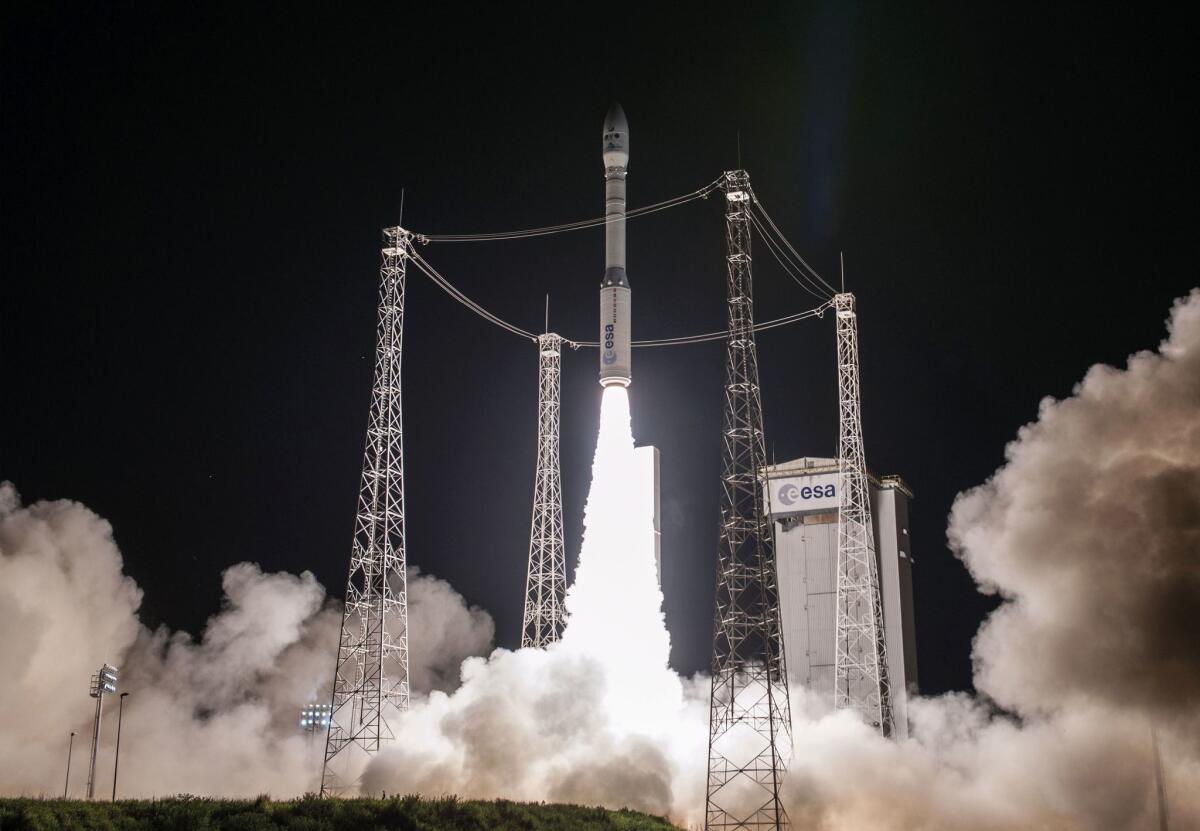Trips to Mars won’t make quick money, but venture capitalists are jumping on other space projects

- Share via
In 2010, Bessemer Venture Partners decided to invest in an intriguing start-up that would build and launch a network of small satellites for a fraction of the typical cost.
Four years later, that small satellite and remote imaging company, Skybox Imaging, was acquired by Google for $500 million in cash. The company, now known as Terra Bella, has launched seven satellites into orbit.
Terra Bella’s lucrative exit, along with the well-publicized exploits of SpaceX, have helped spur increased investment in space and space-related start-ups by top venture capital firms better known for their support of technology companies like Yelp, LinkedIn and Jawbone.
“When we saw that Google, a mainstream tech company, all of a sudden had an interest in space, that was a big moment to realize that space is now important to a lot of companies,” said Sunil Nagaraj, vice president at Silicon Valley-based Bessemer.
And whereas SpaceX Chief Executive Elon Musk has made clear he’s willing to spend billions to establish a base on Mars, these VCs have more down-to-earth goals.
“It’s not just passion projects or philanthropists,” said Nagaraj. “We’re there to make money, and we’re actually seeing that happening.”
In 2015, more than 50 venture capital firms invested in space or space-related companies — the highest number in the 15 years that consultant Tauri Group has been tracking the data.
The $1.8 billion invested in space companies last year also was a high, although that mostly reflects two big investments: a $1-billion stake in SpaceX by Google and Fidelity Investments, and $500 million in satellite constellation firm OneWeb by a group of investors.
Even without these two deals, venture capital investments in space totaled $300 million in 2015, a significant increase from $94.3 million in 2014.
Venture capital overall is flush with money seeking decent returns in a low-yield world. U.S. venture funds raised a total $32 billion from January through September, almost as much as in all of 2015 and a record-setting pace, according to the National Venture Capital Assn.
Much of the interest in the space sector is in small satellite start-ups that capture images of the Earth and in data analytics companies that rely on feeds from small satellites.
That data is valuable to industries such as agriculture, energy and forestry, according to venture capitalists and industry experts.
“You’ve got this confluence of … privatization of the space sector, lower costs of the space sector versus the past, and these large venture funds that are looking for opportunities to deploy capital,” said Robert Siegel, a lecturer in management at Stanford University and partner at XSeed Capital.
Technological advancements such as in batteries and the miniaturization of processors have allowed satellites to shrink dramatically.
In the 1990s and even still today, satellites could be as large as a school bus. Now, they can be the size of a dorm room mini-fridge, or even a shoebox.
“It used to be that if you wanted to do Earth observation … you needed very big satellites,” said Sven Strohband, partner and chief technology officer at Khosla Ventures, which has invested in Skybox, Los Angeles-based Rocket Lab and agricultural data firm Climate Corp, which was acquired by Monsanto Co. in 2013 for $930 million. “You can do an astonishing amount of work with a smaller satellite.”
It costs about as much to launch an app as it does to make and launch a satellite.
— Sunil Nagaraj, vice president, Bessemer Venture Partners
Smaller sizes mean cheaper manufacturing costs, which have allowed companies like Terra Bella and the San Francisco-based Earth-imaging firm Planet to launch so-called satellite constellations that ensure that one or two failures won’t knock out remote-sensing or Earth observation abilities.
Building a shoebox-sized satellite can cost between $100,000 and $300,000, said Nagaraj of Bessemer.
“It costs about as much to launch an app as it does to make and launch a satellite,” he said. “We’ve reduced the cost of entry to start tinkering.”
The firm has invested more than $50 million across three space companies — Skybox, Rocket Lab and small satellite maker Spire.
Venture capitalists say these new satellite constellations should be more successful than those envisioned in the 1990s that were intended to provide telecommunications coverage across the globe.
Because communications networks can’t offer complete service with just one satellite, those constellations are an “all-or-nothing proposition,” Nagaraj said.
But with remote-sensing or Earth observation satellites, “you can derive value starting with satellite No. 1,” he said.
Nagaraj and Strohband said they see one to three space-related pitches a week.
“There seems to be a new attraction to this because it is technologically possible ... and there’s some early proof points that the economics can also be good,” Strohband said. “I think that’s going to continue for at least a little while.”
For more business news, follow me @smasunaga
ALSO
NASA satellite spots remains of Mars lander, which may have exploded during crash landing
Blue Origin aces in-flight escape test as it tries to show space tourists they’ll be safe
Getting humans to Mars will require NASA and private companies to team up, Obama says
More to Read
Inside the business of entertainment
The Wide Shot brings you news, analysis and insights on everything from streaming wars to production — and what it all means for the future.
You may occasionally receive promotional content from the Los Angeles Times.











